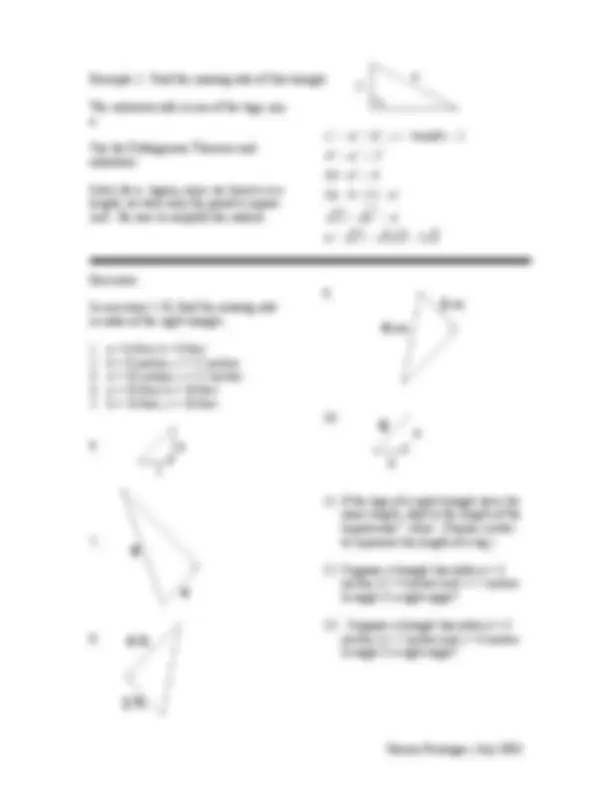



Study with the several resources on Docsity

Earn points by helping other students or get them with a premium plan


Prepare for your exams
Study with the several resources on Docsity

Earn points to download
Earn points by helping other students or get them with a premium plan
Community
Ask the community for help and clear up your study doubts
Discover the best universities in your country according to Docsity users
Free resources
Download our free guides on studying techniques, anxiety management strategies, and thesis advice from Docsity tutors
The concept of right triangles, their angles and sides labels, and introduces the pythagorean theorem. It provides examples on how to use the theorem to find the length of the hypotenuse given the lengths of the legs. Exercises are included for practice.
What you will learn
Typology: Study notes
1 / 2

This page cannot be seen from the preview
Don't miss anything!


Right triangles and the Pythagorean Theorem A right triangle is a triangle with one right angle, that is, one angle that measures 90°. By convention we usually call a right triangle ΔABC, and give the angles and sides the labels shown in this picture. The vertex of the right angle is labeled with the capital letter C; the other vertices are labeled A and B. The right angle is often marked with a small square. The lowercase letters c, a, and b are used to represent the lengths of the sides of the right triangle. The label of a vertex and the label of the opposite side correspond. So the side opposite the right angle C is labeled c; this special side is called the hypotenuse of the right triangle. The side opposite angle A is labeled a; the side opposite angle B is labeled b. These other two sides (not the hypotenuse) are called the legs of the right triangle. The Pythagorean Theorem gives an important relationship among the sides of a right triangle. This Theorem can be used to find the third side of a right triangle when two sides are known. Pythagorean Theorem: Suppose ΔABC is a right triangle with right angle C. Suppose c represents the length of the hypotenuse, and a and b are the lengths of the legs. Then c 2 = a^2 +b^2. Also, if (^) c 2 = a^2 + b^2 for any triangle ΔABC, then the triangle is a right triangle with right angle C. Example 1: Find the hypotenuse of a right triangle whose legs have lengths 5 inches and 12 inches. If a picture isn’t given, draw one and label what you know. You want to find the hypotenuse, which is labeled c. Use the Pythagorean Theorem. Substitute the values you know and solve for c. In the square root step, we take only the positive value since c is a length. c^13 feet c 169 13 c 25 144 169 c 5 12 c a b 2 2 2 2 2 2 2 2 =
Answers to odd exercises on reverse: 1. 10 feet; 3. 5 5 inches; 5. 10 3 feet; 7. 4 3 ;
Example 2: Find the missing side of this triangle. The unknown side is one of the legs, say a. Use the Pythagorean Theorem and substitute. Solve for a. Again, since we know a is a length, we take only the positive square root. Be sure to simplify the radical. a 12 4 3 2 3 12 a a 16 4 12 a 16 a 4 4 a 2 c a b ,c 4 andb 2 2 2 2 2 2 2 2 2 2 = = =
Exercises: In exercises 1-10, find the missing side or sides of the right triangle.
a = 6 feet, b = 8 feet
b = 8 meters, c = 17 meters
a = 10 inches, c = 15 inches
a = 10 feet, b = 20 feet
b = 10 feet, c = 20 feet
If the legs of a right triangle have the same length, what is the length of the hypotenuse? (Hint: Choose a letter to represent the length of a leg.)
Suppose a triangle has sides a = 3 inches, b = 4 inches and c = 5 inches. Is angle C a right angle?
Suppose a triangle has sides a = 4 inches, b = 5 inches and c = 6 inches. Is angle C a right angle? Sharon Persinger, July 2003